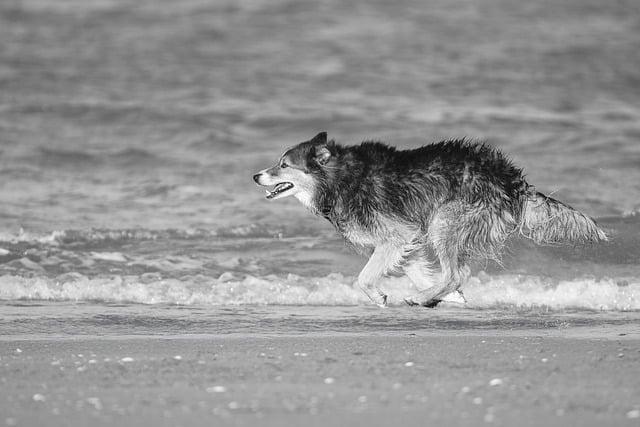Imagine a busy professional named Sarah, who dreams of having a loyal companion but struggles to find time for daily walks. One day, she discovers the innovative world of robotic dogs. These advanced companions don’t require walks, yet they offer companionship, playfulness, and even interactive features that mimic real dogs. With no need for daily outings, Sarah can enjoy the joy of pet ownership without the time commitment. For those who love dogs but lead hectic lives, a robotic dog could be the perfect solution. Why not embrace this modern marvel?
Contents
- Understanding the Exercise Needs of Different Dog Breeds
- Exploring Low-Energy Dog Breeds for Busy Lifestyles
- The Importance of Mental Stimulation in Place of Walks
- Practical Tips for Keeping Your Dog Active Indoors
- Q&A
Understanding the Exercise Needs of Different Dog Breeds
When considering the exercise needs of various dog breeds, it’s essential to recognize that each breed has its unique characteristics and energy levels. For instance, **working breeds** like Border Collies and German Shepherds thrive on physical activity and mental stimulation. These dogs require not only daily walks but also engaging activities such as agility training or herding exercises to keep them happy and healthy. Without adequate exercise, they may develop behavioral issues stemming from boredom and pent-up energy.
On the other hand, **toy breeds** such as Chihuahuas and Pomeranians may not need as much exercise as their larger counterparts. While they still benefit from regular walks, their smaller size allows them to expend energy through playtime indoors. However, it’s crucial to remember that even these breeds require some form of physical activity to maintain their health and prevent obesity. A short daily walk or interactive play session can suffice to meet their needs.
Then we have the **sight hounds**, like Greyhounds and Whippets, which are often misunderstood. Despite their reputation for speed, these breeds are surprisingly low-energy when not in pursuit of a chase. They enjoy short bursts of exercise followed by long periods of rest. A couple of short walks each day, combined with some sprinting in a safe, enclosed area, can satisfy their exercise requirements without overwhelming them.
Lastly, **senior dogs** and those with health issues may have different exercise needs altogether. Many older dogs still enjoy short walks, but their stamina may not match that of younger dogs. It’s essential to tailor exercise routines to accommodate their physical limitations while ensuring they remain active. Gentle strolls and low-impact activities can help maintain their mobility and overall well-being, proving that every dog, regardless of breed or age, benefits from some form of exercise.
Exploring Low-Energy Dog Breeds for Busy Lifestyles
For those with a hectic schedule, finding a canine companion that aligns with a busy lifestyle can be a challenge. Fortunately, there are several breeds known for their low-energy levels, making them ideal for individuals or families who may not have the time for extensive daily exercise. These dogs are not only affectionate and loyal but also adapt well to a more relaxed living environment.
When considering a low-energy breed, it’s essential to look at their temperament and exercise needs. Some breeds thrive on minimal activity and are perfectly content with short play sessions or leisurely strolls around the yard. Here are a few breeds that fit this description:
- Basset Hound: Known for their laid-back nature, Basset Hounds enjoy lounging and are satisfied with moderate exercise.
- Shih Tzu: These small dogs are affectionate and require only short walks, making them perfect for apartment living.
- Bulldog: With their calm demeanor, Bulldogs prefer short bursts of activity and are happy to relax for most of the day.
- Pug: Pugs are playful yet low-energy, thriving on companionship rather than vigorous exercise.
Another advantage of low-energy breeds is their adaptability to indoor living. Many of these dogs are perfectly content to play with toys or cuddle on the couch, making them excellent companions for those who work long hours or have a busy home life. Their lower exercise requirements mean that they can thrive in smaller living spaces without the need for extensive outdoor time.
Choosing a dog that aligns with your lifestyle can lead to a fulfilling relationship without the stress of meeting high exercise demands. By selecting a breed that naturally requires less physical activity, you can enjoy the companionship of a dog while maintaining your busy schedule. These breeds not only offer love and loyalty but also fit seamlessly into the rhythm of your life, allowing you to focus on your commitments without sacrificing the joy of pet ownership.
The Importance of Mental Stimulation in Place of Walks
While physical exercise is crucial for a dog’s well-being, mental stimulation can often serve as a powerful substitute for traditional walks. Engaging a dog’s mind can lead to a more balanced and fulfilled pet, reducing anxiety and destructive behaviors that often arise from boredom. By incorporating various activities that challenge their intellect, you can create a stimulating environment that keeps your dog happy and healthy.
Consider the following activities that can effectively replace the need for long walks:
- Interactive Toys: Puzzle toys that dispense treats can keep your dog occupied for hours, encouraging problem-solving and critical thinking.
- Training Sessions: Teaching new commands or tricks not only reinforces good behavior but also provides mental exercise that can tire your dog out just as much as a physical walk.
- Scent Games: Hide treats around the house or yard and let your dog use their nose to find them. This taps into their natural instincts and provides a rewarding challenge.
- Obstacle Courses: Set up a mini agility course in your backyard or living room. Navigating through tunnels, jumps, and weave poles can be both fun and mentally stimulating.
Moreover, mental stimulation can be particularly beneficial for certain breeds that may not require extensive physical exercise. Breeds like Bulldogs or Basset Hounds, known for their lower energy levels, can thrive on cognitive challenges rather than long walks. By focusing on their mental needs, you can ensure they remain engaged and content without the pressure of daily outings.
Incorporating mental stimulation into your dog’s routine not only enhances their quality of life but also strengthens the bond between you and your pet. Engaging in these activities together fosters trust and communication, making for a happier and more harmonious relationship. Ultimately, understanding that mental exercise can be just as vital as physical activity opens up new avenues for keeping your dog healthy and satisfied.
Practical Tips for Keeping Your Dog Active Indoors
Keeping your dog active indoors can be both fun and rewarding. One effective way to engage your furry friend is through interactive toys. These toys stimulate your dog’s mind and body, encouraging them to play and stay active. Look for options that dispense treats or require problem-solving skills. **Puzzle toys** and **snuffle mats** are excellent choices that can keep your dog entertained for hours while also providing mental stimulation.
Another great method to ensure your dog gets enough exercise indoors is to create an obstacle course. Use household items like chairs, cushions, and boxes to set up a fun and challenging course. Encourage your dog to jump over, crawl under, or weave through the obstacles. This not only helps with physical activity but also enhances their agility and coordination. **Incorporate commands** like “jump” or “crawl” to reinforce training while having fun.
Engaging in games like hide and seek can also be a fantastic way to keep your dog active. Start by having your dog stay in one room while you hide in another. Once you’re hidden, call your dog to come find you. This game taps into their natural instincts and provides both mental and physical exercise. **Reward them** with treats or praise when they successfully locate you, reinforcing positive behavior and making the game even more enjoyable.
Lastly, consider incorporating short training sessions throughout the day. Teaching your dog new tricks or reinforcing existing commands can be a great way to keep their mind sharp and their body moving. Use positive reinforcement techniques to encourage your dog, and keep the sessions short and engaging. **Training not only builds a stronger bond** between you and your dog but also ensures they remain active and stimulated, even when confined indoors.
Q&A
-
Are there dog breeds that require little to no walking?
Yes, certain dog breeds are known for their low exercise needs. Breeds like the French Bulldog, Shih Tzu, and Bulldog are generally more sedentary and can thrive with minimal physical activity. However, they still benefit from short play sessions and mental stimulation.
-
Can indoor dogs be happy without walks?
Absolutely! Dogs can be content without regular walks if they receive adequate mental stimulation and playtime indoors. Engaging them with toys, training exercises, and interactive games can fulfill their needs and keep them happy.
-
What are the consequences of not walking a dog?
While some dogs may not require extensive walks, all dogs need some form of exercise to maintain their health. Lack of activity can lead to obesity, behavioral issues, and boredom. It’s essential to find alternative ways to keep them active and engaged.
-
Are there alternatives to walking for exercise?
Yes, there are several alternatives to walking that can provide exercise for dogs. Options include playing fetch, using a treadmill, engaging in agility training, or even taking them to a dog park where they can run freely. These activities can be just as beneficial as traditional walks.
while no dog can entirely forgo exercise, certain breeds require less walking and can thrive in a more sedentary lifestyle. Choosing the right dog for your lifestyle can lead to a fulfilling companionship without the daily demands of long walks.

大家好,我是彼得潘,專業的手法身體治療師。我喜歡探索和研究各種主題,並透過與人工智慧的合作分享專業、實用、有趣的文章。我們定期進行人工審核,以確保內容的準確性。如果您發現文章中有任何不準確的地方,請隨時與我們聯繫,我們會及時糾正。您可以透過 [email protected] 與我們聯繫。



